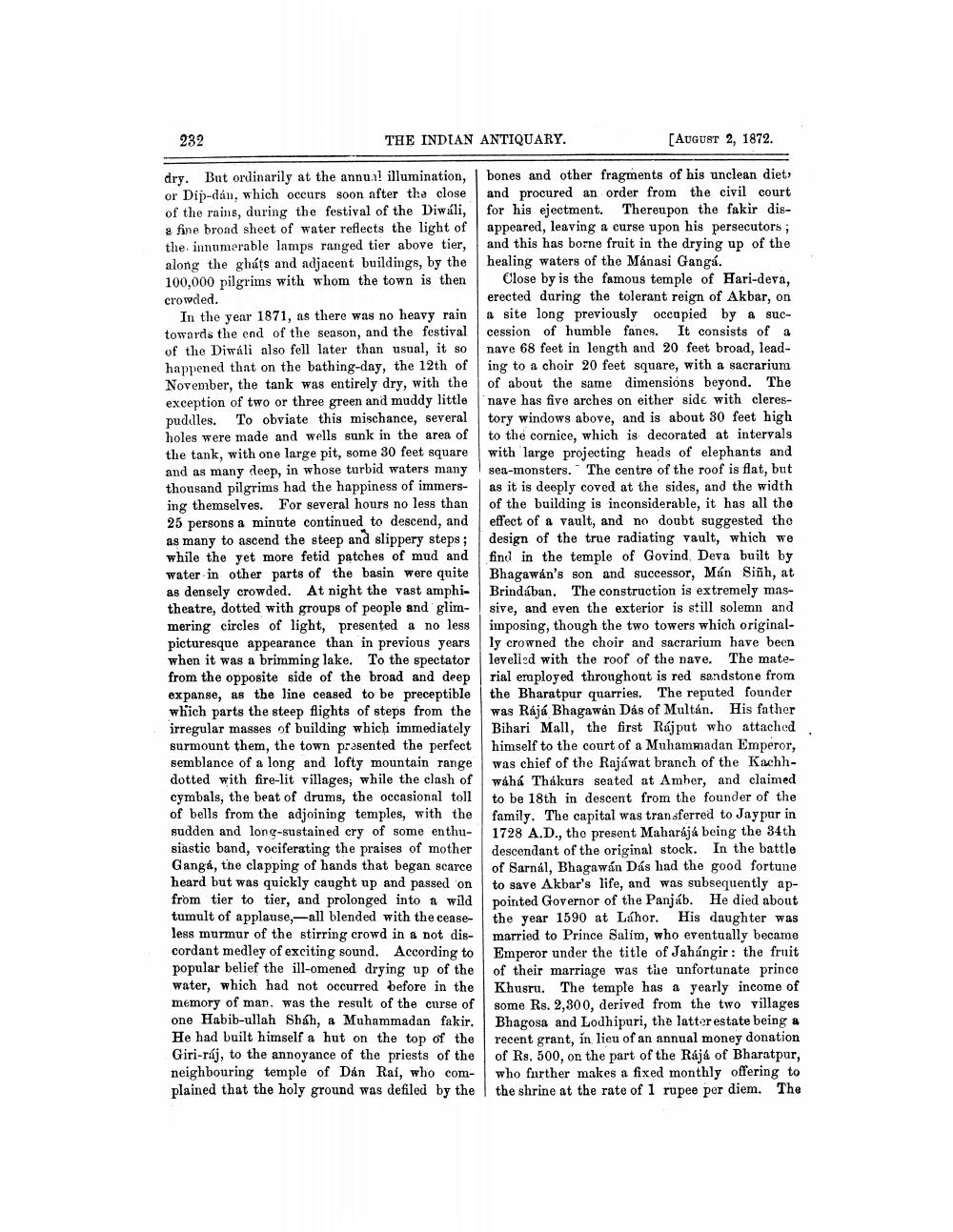________________
232
THE INDIAN ANTIQUARY.
[AUGUST 2, 1872.
dry. But ordinarily at the annual illumination, or Dip-dán, which occurs soon after the close of the rains, during the festival of the Diwali, a fine broad sheet of water reflects the light of the innumerable lamps ranged tier above tier, along the gháts and adjacent buildings, by the 100,000 pilgrims with whom the town is then crowded.
In the year 1871, as there was no heavy rain towards the end of the season, and the festival of the Diwali also fell later than usual, it so happened that on the bathing-day, the 12th of November, the tank was entirely dry, with the exception of two or three green and muddy little puddles. To obviate this mischance, several holes were made and wells sunk in the area of the tank, with one large pit, some 30 feet square and as many deep, in whose turbid waters many thousand pilgrims had the happiness of immers- ing themselves. For several hours no less than 25 persons a minute continued to descend, and as many to ascend the steep and slippery steps; while the yet more fetid patches of mud and water in other parts of the basin were quite as densely crowded. At night the vast amphitheatre, dotted with groups of people and glimmering circles of light, presented a no less picturesque appearance than in previous years when it was a brimming lake. To the spectator from the opposite side of the broad and deep expanse, as the line ceased to be preceptible which parts the steep flights of steps from the irregular masses of building which immediately surmount them, the town presented the perfect semblance of a long and lofty mountain range dotted with fire-lit villages; while the clash of cymbals, the beat of drums, the occasional toll of bells from the adjoining temples, with the sudden and long-sustained cry of some enthusiastic band, vociferating the praises of mother Gangá, the clapping of hands that began scarce heard but was quickly caught up and passed on from tier to tier, and prolonged into a wild tumult of applause,-all blended with the ceaseless murmur of the stirring crowd in a not discordant medley of exciting sound. According to popular belief the ill-omened drying up of the water, which had not occurred before in the memory of man, was the result of the curse of one Habib-ullah Shah, a Muhammadan fakir. He had built himself a hut on the top of the Giri-ráj, to the annoyance of the priests of the neighbouring temple of Dán Rai, who complained that the holy ground was defiled by the
bones and other fragments of his unclean diet and procured an order from the civil court for his ejectment. Thereupon the fakir disappeared, leaving a curse upon his persecutors; and this has borne fruit in the drying up of the healing waters of the Mánasi Gangá.
Close by is the famous temple of Hari-deva, erected during the tolerant reign of Akbar, on a site long previously occupied by a succession of humble fanes. It consists of a nave 68 feet in length and 20 feet broad, leading to a choir 20 feet square, with a sacrarium of about the same dimensions beyond. The nave has five arches on either side with clerestory windows above, and is about 30 feet high to the cornice, which is decorated at intervals with large projecting heads of elephants and sen-monsters. The centre of the roof is flat, but as it is deeply coved at the sides, and the width of the building is inconsiderable, it has all the effect of a vault, and no doubt suggested the design of the true radiating vault, which we find in the temple of Govind, Deva built by Bhagawan's son and successor, Mán Sinh, at Brindában. The construction is extremely massive, and even the exterior is still solemn and imposing, though the two towers which originally crowned the choir and sacrarium have been levelled with the roof of the nave. The material eroployed throughout is red sandstone from the Bharatpur quarries. The reputed founder was Rájá Bhagawan Dás of Multán. His father Bihari Mall, the first Rájput who attached himself to the court of a Muhammadan Emperor, was chief of the Rajáwat branch of the Kachhwáhá Thákurs seated at Amber, and claimed to be 18th in descent from the founder of the family. The capital was transferred to Jaypur in 1728 A.D., the present Maharajá being the 34th descendant of the original stock. In the battle of Sarnál, Bhagawán Dás had the good fortune to save Akbar's life, and was subsequently appointed Governor of the Panjáb. He died about the year 1590 at Láhor. His daughter was married to Prince Salim, who eventually became Emperor under the title of Jahángir: the fruit of their marriage was the unfortunate prince Khusru. The temple has a yearly income of some Rs. 2,300, derived from the two villages Bhagosa and Lodhipuri, the latter estate being a recent grant, in lieu of an annual money donation of Rs. 500, on the part of the Rájá of Bharatpur, who further makes a fixed monthly offering to the shrine at the rate of 1 rupee per diem. The




